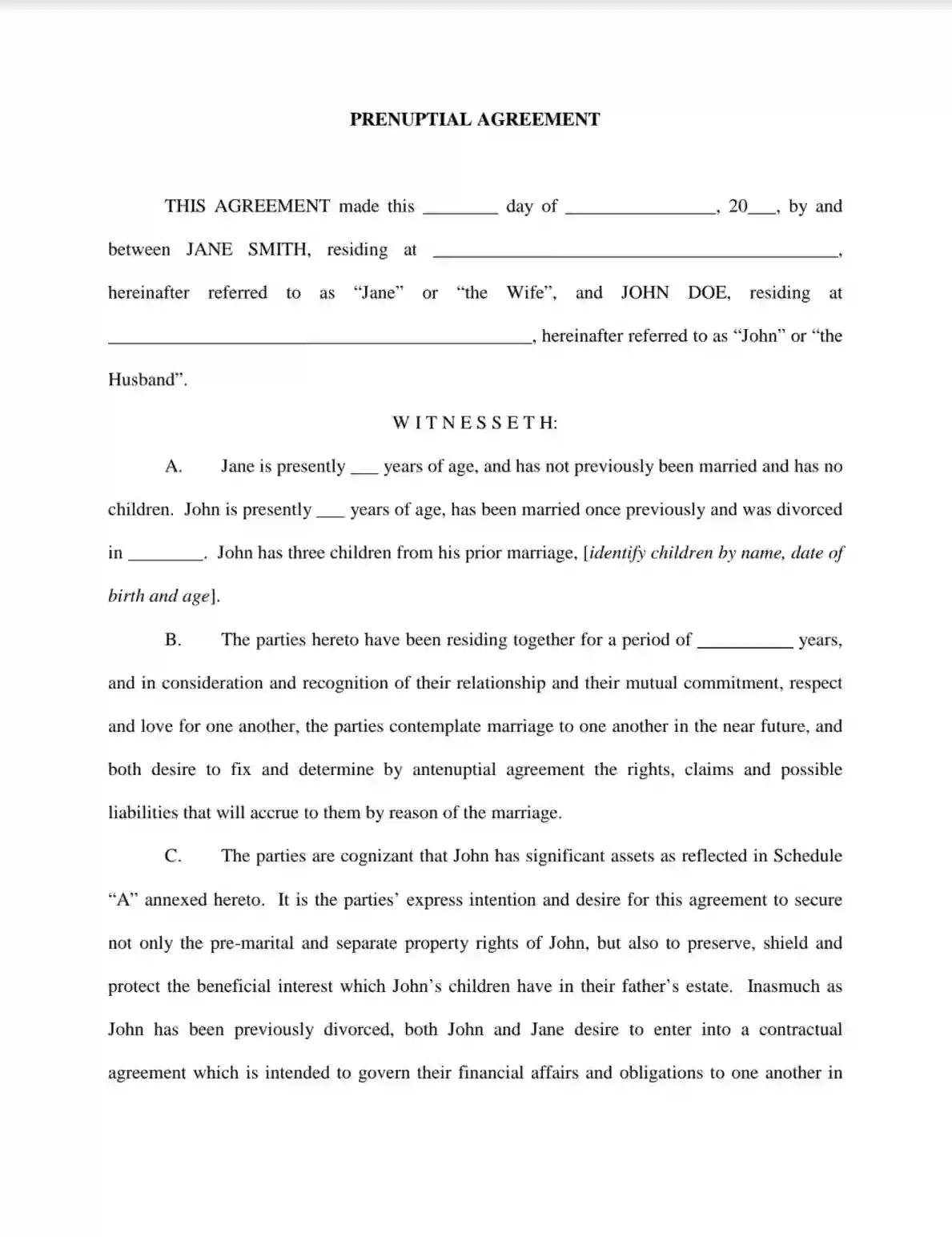Prenuptial Agreement Template
A prenuptial agreement, also known as a premarital or antenuptial agreement, or simply a prenup, is a legally binding contract concluded between romantic partners before the marriage or civil union. A prenup regulates the parties’ affairs in the event of a divorce, death, or other regrettable experience. Usually, prenups include spouses’ financial responsibilities and obligations.
Proposing to sign a prenuptial agreement can be seen as an anti-romantic idea. One of the spouses may interpret it as an expression of distrust or anticipation of something bad to happen. However, a lot of divorces come specifically from the property and financial disagreements. As a legal document, a prenuptial agreement controls these issues and shows the couple’s serious intentions to be together.
While some believe a prenup is bad luck, others use it as a business partnership agreement, which will protect both parties if something goes wrong. Our free prenuptial agreement template will lessen the burden of structuring all the necessary information to be covered in the document. You can also take advantage of our guidelines on how to prepare and write a prenuptial agreement.

Build Your Document
Answer a few simple questions to make your document in minutes
Save and Print
Save progress and finish on any device, download and print anytime
Sign and Use
Your valid, lawyer-approved document is ready
- Alabama
- Alaska
- Arizona
- Arkansas
- California
- Colorado
- Connecticut
- Delaware
- Florida
- Georgia
- Hawaii
- Idaho
- Illinois
- Indiana
- Iowa
- Kansas
- Kentucky
- Louisiana
- Maine
- Maryland
- Massachusetts
- Michigan
- Minnesota
- Mississippi
- Missouri
- Montana
- Nebraska
- Nevada
- New Hampshire
- New Jersey
- New Mexico
- New York
- North Carolina
- North Dakota
- Ohio
- Oklahoma
- Oregon
- Pennsylvania
- Rhode Island
- South Carolina
- South Dakota
- Tennessee
- Texas
- Utah
- Vermont
- Virginia
- Washington
- West Virginia
- Wisconsin
- Wyoming
When It Is Useful to Have a Prenuptial Agreement
As a general rule, a prenuptial agreement is a common practice. It doesn’t just come in handy if people are rich celebrities and want to protect their vast wealth. Prenuptial agreements can also be useful for a single parent who is going to remarry or for a spouse who wants to keep the family business separate. In these cases, prenups will protect the child’s heirloom or valuable property of the birth family. Some of the main reasons to use a prenuptial agreement are:
- You want to protect things you have worked hard to achieve.
Sometimes, before finding the love of their life, people have been a part of the family business. Naturally, they may want to keep the birth family property separate from their new life. The desire to set individual financial assets aside is also fair when one spouse earns considerably more than the other or has some retirement benefits. A prenuptial agreement will be helpful if you think about starting your own business.
- You want to distinguish between community and separate property.
A good thing about prenups is that they allow parties to distinguish what is separate and community property after the marriage. It lessens the burden of property division in the potential event of marriage dissolution. Without a prenuptial agreement, all property will be divided according to state laws. Some states have community property, providing that all the property acquired during the marriage is owned by both spouses equally; thus, it should be split 50/50 after the separation. A valid prenup will help to avoid court involvement in deciding what happens to your property.
- You have children from a previous marriage.
The future marriage or civil union might not be your first time, and you may have children from previous relationships. The desire to secure an inheritance or share of your property for them comes naturally before you get married for the second or any subsequent time. Not using the prenuptial agreement can lead to the transfer of your heirloom right to your spouse. Even with a will, a prenuptial agreement can strengthen the children’s rights.
- You plan to give up your career for your family.
One of the parties can decide to devote the majority of time to raise children or to help the other spouse’s career. Despite many prejudices, it’s a common practice nowadays. Unfortunately, it is also common when the stay-at-home spouse is left with nothing after the separation. A prenuptial agreement is a good way to avoid such a regrettable experience.
- You don’t want to share your partner’s debts.
A prenuptial agreement is also a good way to protect each spouse from a large number of personal debts. Sometimes, one of the partners brings unexpectedly huge debts to married life. Moreover, personal debt can accrue during the marriage. To avoid any unpleasant disagreement on this issue, everyone should be responsible for their own debts.
- You plan to set some rules for married life.
These provisions can include information about cheating or similar infidelities. For example, a prenuptial agreement can contain a rule that one partner gives up all rights to property or other assets if there is evidence of his or her adultery.
What Are the Pros and Cons of Using a Prenuptial Agreement?
Every couple is unique, and prenuptial agreements do not suit everyone. That’s why before starting a big discussion with your partner, consider all the advantages and drawbacks of signing the agreement. If you want to live together without the official marriage, you can conclude a domestic partnership agreement, also known as a cohabitation agreement. It works similarly to the premarital agreement and clarifies the relationship’s financial obligations and possible actions in the unfortunate event of separation. Here are some main advantages of using such agreements:
- They secure your individual property, financial, or family assets.
- They clearly define what is the community and separate property after the marriage, and how it would be divided in the event of a divorce.
- They secure children’s inheritance (in case you have children from previous relationships).
- They help you to avoid the possible high debts of your partner.
- They set an overall legal control of the financial part of your relationships.
However, it would help if you also considered some drawbacks of using such agreements, which can cast a shadow on your romantic relationship:
- They can provoke distrust between the partners.
- They cannot include provisions on child custody and support.
- They can lead to an unfair division of entitlements.
- They can be voided, or the court may set aside some provisions, such as personal issues.
How to Prepare for a Prenuptial Agreement
If you have analyzed all the pros and cons of a prenuptial agreement and decided that it perfectly suits your situation, do not rush in writing the document. First, prepare yourself and your partner for the process, following the next steps:
Step 1. Discuss the possibility to sign the agreement

The preparation process begins with the discussion. It might be the hardest part of the process because, at some point, it can hurt the spouses’ feelings. However, if the partners leave the emotional aspect aside, they will understand all the decision’s seriousness, and it will be much easier for them to work on the agreement.
Step 2. Find legal advice for each party

After agreeing to create and sign the prenuptial agreement, it is necessary to find legal counsel. To be valid, some states require that either party obtains independent legal advice. That means each lawyer should not be associated with the other party.
Step 3. Define the assets you want to cover in the agreement

If you decide to sign the prenuptial agreement, there shouldn’t be any secrets between you and your partner. It’s important to disclose all debts, real estate, retirement accounts, and other relevant financial information. Hiding some important information about your assets can lead to your future prenup being regarded as legally invalid.
Step 4. Negotiate the terms of the agreement

During the preparation stage, spouses should negotiate in detail the terms of future prenup. The terms may include both property obligations and information about what to do in case of adultery or cheating. You should clearly lay out your financial obligations and responsibilities about every aspect of the agreement. However, you have to avoid writing such personal issues as daily duties or tasks because they make the contract look less serious.
Step 5. Consult the state requirements

As mentioned above, some states have community property, which provides equal marital assets division after marriage dissolution. However, state law can strive not for equality but equitability. For example, Alaska is an opt-in community property state, which means that the parties can decide on their own how to divide the property. It’s also important to consult the state laws because some of them may cover all of the issues you want to include in your prenup, so you might not need one. The majority of states have adopted the Uniform Premarital Agreement Act (UPAA/UPMAA), which regulates the prenuptial agreement issues. You should also check signing requirements, as they vary from state to state.
What to Include in a Prenuptial Agreement
Prenuptial agreements are mostly concluded to secure parties’ properties and set good control over the marriage’s financial part. You should consider the following provisions to include in your prenup:
- Marital and separate property
Separate property, also known as non-marital property, usually includes the property each spouse had before getting married, including the inheritance and gifts. Community property, also known as marital property, usually includes assets acquired during the marriage. As we already know, without a prenuptial agreement, these assets will be divided according to the existing law; that is, it will be split 50-50. A prenup allows spouses to control property and choose how to divide it based on the couple’s unique needs.
- Marital and separate debts
Another important issue to cover in the prenuptial agreement is personal debts. As mentioned above, financial disagreements are often the main reasons for separation. To avoid them, you should thoroughly approach the debt issue. For this purpose, each spouse should fully disclose the financial assets and identify the division of debts in marriage—whether the marital debts will be shared or each spouse will be responsible for their own debts. Sometimes, one party brings such a huge amount of debt that it would be unfair to divide it equally in marriage.
- Spousal support
The spousal support provisions limit any unfair economic effect of a divorce or partner’s death. Depending on the marriage length, non-earning or lower-earning spouses can get financial support, including short or long-term payments. The justification for spousal support is that one of the parties may have decided to give up a family career and now needs time and resources to get back on track.
- Inheritance rights of children from a previous marriage
It’s necessary to include in the prenup inheritance rights of your previous children (if any) so that they can get their heirloom or the part of your property. A prenuptial agreement takes care of your children and grandchildren, securing the inheritance in the event of death. It also helps to avoid long legal battles during such a difficult period.
Note that some information cannot be regarded as appropriate for a prenuptial agreement and, as a result, cannot be covered in the contract, such as:
- Child support and custody
You can decide together with your partner how to handle your future parenting time, but it’s impossible to define the child custody or the amount of support in the potential event of a divorce. It’s up to the judge to make these decisions under the circumstances at that time and in the child’s best interest.
- Daily tasks and duties
Defining daily tasks and duties in the agreement can cast a shadow on the seriousness of the prenup. Moreover, these provisions will not be regarded as enforceable and, as a result, will be useless.
- Provisions that encourage divorce
Some of the agreement’s provisions may be considered as the ones that encourage divorce, such as monetary incentives. These provisions, if not the whole agreement, will be set aside by the judge.
Prenup State Laws
| State | Signing Requirements | Community Property Laws | Uniform Premarital Agreement Act |
| Alabama (AL) | No statute (signatures of both parties recommended) | No | No |
| Alaska (AK) | No statute (signatures of both parties recommended) | Yes (opt-in) | No |
| Arizona (AZ) | Signed by both parties (§ 25-202) | Yes | Yes |
| Arkansas (AR) | Signed by both parties and notarized (AR Code § 9-11-402) | No | Yes |
| California (CA) | Signed by both parties (CA Fam Code § 1611) | Yes | Yes |
| Colorado (CO) | In a record and signed by both parties (§ 14-2-306) | No | Yes |
| Connecticut (CT) | Signed by both parties (Sec. 46b-36c) | No | Yes |
| Delaware (DE) | Signed by both parties (§ 322 Formalities) | No | Yes |
| District of Columbia (D.C.) | Signed by both parties (§ 46–502) | No | Yes |
| Florida (FL) | Signed by both parties (§ 61.079 (3)) | No | Yes |
| Georgia (GA) | Signed by both parties and attested by one (1) witness and a notary public (§ 19-3-62) | No | No |
| Hawaii (HI) | Signed by both parties (§ 572D-2 Formalities) | No | Yes |
| Idaho (ID) | Signed by both parties (§ 32-922. Formalities) | Yes | Yes |
| Illinois (IL) | Signed by both parties (750 ILCS 10/3) | No | Yes |
| Indiana (IN) | Signed by both parties (IC 31-11-3-4) | No | Yes |
| Iowa (IA) | Signed by both parties (§ 596.4 Formalities) | No | Yes |
| Kansas (KS) | Signed by both parties (§ 23-2403) | No | Yes |
| Kentucky (KY) | Signed by both parties (KRS 371.010) | No | No |
| Louisiana (LA) | Signed by both parties and notarized (CC 2331) | Yes | No |
| Maine (ME) | Signed by both parties (§603. Formalities) | No | Yes |
| Maryland (MD) | Signed by both parties (Legal Rights in Marriage & Divorce in Maryland, Chapter 2) | No | No |
| Massachusetts (MA) | Must be recorded in the Registry of Deeds where the husband resides (Part II, Title III, Chapter 209, Section 26) | No | No |
| Michigan (MI) | Signed by both parties (§ 566.132, Sec. 2(1)) | No | No |
| Minnesota (MN) | Signed by both parties and attested by two (2) witness and a notary public (§ 519.11, Subdivision 2) | No | No |
| Mississippi (MS) | Signed by both parties (Senate Bill 2697 Sec. 3) | No | No |
| Missouri (MO) | Signed by both parties and notarized (§ 451.220) | No | No |
| Montana (MT) | Signed by both parties (§ 40-2-604) | No | Yes |
| Nebraska (NE) | Signed by both parties (§ 42-1003) | No | Yes |
| Nevada (NV) | Signed by both parties (NRS 123A.040) | Yes | Yes |
| New Hampshire (NH) | Signed by both parties (§ 460:2-a) | No | No |
| New Jersey (NJ) | Signed by both parties (§ 37:2-33) | No | Yes |
| New Mexico (NM) | Signed by both parties and notarized (§ 40-3A-3) | Yes | Yes |
| New York (NY) | Signed by both parties and notarized (DRL 236B(3)) | No | No |
| North Carolina (NC) | Signed by both parties (§ 52B-3) | No | Yes |
| North Dakota (ND) | In a record and signed by both parties (§ 14-03.2-05) | No | Yes |
| Ohio (OH) | Signed by both parties (§ 1335.05) | No | No |
| Oklahoma (OK) | Signed by both parties (§ 43-121(B)) | No | No |
| Oregon (OR) | Signed by both parties (§ 108.705) | No | Yes |
| Pennsylvania (PA) | Signed by both parties (§ 3106) | No | No |
| Rhode Island (RI) | Signed by both parties (§ 15-17-2) | No | Yes |
| South Carolina (SC) | Signed by both parties (S.C.Code Ann. §20-5-50) | No | No |
| South Dakota (SD) | Signed by both parties (§ 25-2-17) | No | Yes |
| Tennessee (TN) | Signed by both parties (§ 36-3-501) | No | No |
| Texas (TX) | Signed by both parties (§ 4.002) | Yes | Yes |
| Utah (UT) | Signed by both parties (§ 30-8-3) | No | Yes |
| Vermont (VT) | No statute (signatures of both parties recommended) | No | No |
| Virginia (VA) | Signed by both parties (§ 20-149) | No | Yes |
| Washington (WA) | Signed by both parties, witnessed, acknowledged and certified in the same manner as deeds to real estate (RCW 26.16.120) | Yes | No |
| West Virginia (WV) | Signed by both parties (§ 48-1-203) | No | No |
| Wisconsin (WI) | No statute (signatures of both parties recommended) | Yes | Yes |
| Wyoming (WY) | Signed by both parties (§1-23-105) | No | No |
How to Write a Prenuptial Agreement
When you have passed the preparation stage and defined all the necessary information to include in the document, it’s time to begin the writing process. Creating a prenuptial agreement should be an easy task with our free prenuptial agreement template. However, you are also encouraged to consult the attorney. Generally, writing a prenup include the following steps:
Step 1. Enter the dates
You should enter both the date of signing the prenup and its effective date. The effective date, that is when the agreement becomes enforceable, is usually the wedding date. If the couple does not marry on this day, the document will be considered null and void.
Step 2. Identify the parties
Naturally, you should identify the parties of the agreement who are contemplating marriage to each other. You can also shortly describe the purpose of the prenup and provide the acknowledgment that the agreement has been executed voluntarily, under no duress or undue influence, and within a reasonable period of time.
Step 3. Define the terms of the agreement
It’s the most important part of the prenup. Here, you define joint legal rights, obligations, and liabilities negotiated during the agreement’s preparation stage. It’s necessary to make sure that all the parties’ assets are fully disclosed to each other. The terms of the document include separate property owned by each party and community property acquired during the marriage, marital and non-marital debts, and liabilities in case of cheating. In the contract, parties agree on spousal support and alimony. It’s possible to add the amendment and revocation provisions or the sunset clause (the period after which the agreement will automatically expire) to the agreement’s terms.
Step 4. Identify the governing laws
The governing law or laws are crucial to mention. You should choose the jurisdiction where you and your spouse live most of the time. As mentioned above, some states have community property, which influences how the property will be divided in the unfortunate event of the marriage dissolution.
Step 5. Sign the agreement
Signing requirements vary from state to state. However, it is highly recommended that either party signs the prenuptial agreement before a notary public. Depending on the jurisdiction under which your document is executed, the agreement may have to be attested by a witness(-es). Make sure that you sign the agreement well in advance. Signing the prenup at the last minute is not advisable because the court can invalidate it.
Step 6. Add exhibits to the prenup
It’s necessary to add exhibits to the signed agreement, containing all the financial information, debts (if any), retirement accounts or benefits, and real estate. Make sure to also add certificates of legal advice, which prove that either spouse has an individual lawyer.
Frequently Asked Questions
When Can a Prenuptial Agreement Be Voided?
A prenuptial agreement can be voided in the following cases:
- It’s not written. A prenuptial agreement cannot be oral.
- Not all financial assets are disclosed. If one party hides the significant assets or undervalues property owned before marriage, then the prenup’s provisions cannot be legal.
- One of the spouses is treated unfairly. Such things as waiving the alimony or spousal support can be considered as unconscionable.
- It’s improperly signed. The prenup should be signed well in advance. If it’s signed one day before the wedding, the agreement may be interpreted as signed under duress. Moreover, each state has its signing requirements, and if the agreement is not created according to state law, it can be considered invalid.
- One lawyer for both parties. Each party is recommended to have a separate lawyer before entering into the agreement. Spouses who sign prenuptial agreements without legal representation are at risk of being treated unfairly.
- Incorrect filing procedure. The prenup should be properly filled in. Even a misspelling can invalidate the agreement.
Can I Nullify the Prenuptial Agreement?
Yes, you can nullify the prenup if one of the aforementioned issues arise. In this case, your document is considered void. However, termination of the contract can also be agreed upon by both parties. In this case, they should prepare a revocation certified by a notary public. A prenuptial agreement can also provide a sunset clause, which establishes the period after which the legal document will automatically expire.
Is It Possible to Sign a Prenuptial Agreement after the Wedding?
Yes, it’s possible to sign the agreement after the wedding. It’s called a postnuptial agreement or simply a postnup. Postnups are similar to prenups and the main difference is the time of signing. Sometimes, postnuptial agreements can be more suitable for spouses, who do not want to ruin the “honeymoon” period of the relationship. Such a document can come in handy when parties agree on the new terms of the agreement and want to change the prenup after the wedding.
What Is the Uniform Premarital Agreement Act?
The Uniform Premarital Agreement Act (UPAA/UPMAA) is a multi-state law determining when and how prenuptial agreements should be enforced. It allows parties to conclude fair prenups, choosing which state law to apply in terms of property division and spousal support. To date, the UPAA/UPMAA has been adopted by 28 states and the District of Columbia. However, premarital agreements are still recognized as binding in the other 22 states.
What Is the Difference Between a Prenuptial Agreement and a Conflict Resolution Agreement?
A prenuptial agreement addresses financial assets and property and defines what will happen to them if the marriage will not last. A conflict resolution agreement, in its turn, does not address any financial aspects of the marriage but outlines how the couples will try to resolve conflict if it gets to the point that they’re considering a divorce. Therefore, a prenup provides couples with liabilities and possible actions in the event of separation, while a conflict resolution agreement tries to save couples from the divorce.